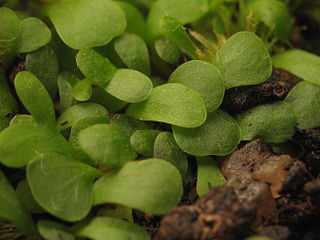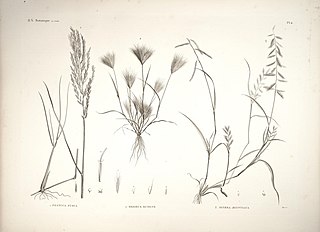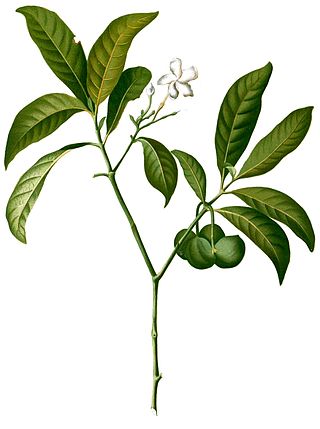
Rauvolfia is a genus of evergreen trees and shrubs, commonly known as devil peppers, in the family Apocynaceae. The genus is named to honor Leonhard Rauwolf. The genus can mainly be found in tropical regions of Africa, Asia, Latin America, and various oceanic islands.

Adenium is a genus of flowering plants in the family Apocynaceae first described as a genus in 1819. It is native to Africa and the Arabian Peninsula.
Hunteria is a genus of plants in the family Apocynaceae first described as a genus in 1824. It is native to Africa and to South and Southeast Asia.
- Hunteria ballayiHua - Central African Republic, Republic of Congo, Cameroon, Gabon
- Hunteria camerunensisK.Schum. ex Hallier f. - Republic of Congo, Cameroon, Gabon
- Hunteria congolanaPichon - Republic of Congo, Zaïre, Kenya
- Hunteria densifloraPichon - Zaïre
- Hunteria ghanensisJ.B.Hall & Leeuwenb. - Ivory Coast, Ghana
- Hunteria hexaloba(Pichon) Omino - Gabon
- Hunteria macrosiphonOmino - Republic of Congo, Gabon
- Hunteria myrianthaOmino - Zaïre
- Hunteria oxyanthaOmino - Republic of Congo, Zaïre, Gabon
- Hunteria simii(Stapf) H.Huber - Guinea, Ivory Coast, Liberia, Sierra Leone
- Hunteria umbellata(K.Schum) Hallier f. - W + C Africa from Senegal to Zaïre
- Hunteria zeylanica(Retz.) Gardner ex Thwaites - Somalia, Kenya, Tanzania, Mozambique, S China, India, Sri Lanka, Andaman & Nicobar Islands, Indochina, W Malaysia, Sumatra

Kibatalia is a genus of trees and shrubs in the family Apocynaceae, tribe Malouetieae, first described as a genus in 1826. It was initially called Hasseltia, but this turned out to be an illegitimate homonym. So Kibatalia was chosen as a replacement name. Kibatalia is native to China and Southeast Asia.
- Kibatalia arborea(Blume) G.Don – Thailand, Philippines, W Malaysia, Borneo, Sumatra, Java, Sulawesi
- Kibatalia blancoi(Rolfe ex Stapf) Merr. – Philippines
- Kibatalia borneensis(Stapf) Merr. – Sarawak
- Kibatalia elmeriWoodson – Luzon
- Kibatalia gitingensis(Elmer) Woodson – Philippines
- Kibatalia laurifolia(Ridl.) Woodson – Vietnam, Cambodia, Thailand, W Malaysia
- Kibatalia longifoliaMerr. – Mindanao
- Kibatalia macgregori(Elmer) Woodson – Sibuyan
- Kibatalia macrophylla(Pierre ex Hua) Woodson – Yunnan, Indochina
- Kibatalia maingayi(Hook.f.) Woodson – Thailand, W Malaysia, Borneo, Sumatra, Mindanao
- Kibatalia merrillianaWoodson – Leyte, Samar
- Kibatalia puberulaMerr. – Samar in Philippines
- Kibatalia stenopetalaMerr. – Luzon, Dinagat, Mindanao
- Kibatalia villosaRudjiman – W Malaysia, Borneo
- Kibatalia wigmani(Koord.) Merr. – Sulawesi
- Kibatalia africana(Benth.) Merr. = Funtumia africana(Benth.) Stapf
- Kibatalia elastica(Preuss) Merr. = Funtumia elastica(Preuss) Stapf
- Kibatalia latifolia(Stapf) Merr. = Funtumia africana(Benth.) Stapf
- Kibatalia scheffieri(K.Schum.) Merr. = Funtumia africana(Benth.) Stapf
- Kibatalia zenkeri(K.Schum.) Merr. = Funtumia africana(Benth.) Stapf

Ranalisma is a genus in the family Alismataceae. It includes two species; one from tropical Africa and the other from southeast Asia.

Burkea africana, the wild syringa, is a deciduous, medium-sized, spreading, flat-topped tree which grows in the woodlands and savannas of sub-Saharan Africa. It is the sole species in genus Burkea, which belongs to the subfamily Caesalpinioideae of the family Fabaceae.

Utricularia arenaria is a small annual carnivorous plant that belongs to the genus Utricularia. It is native to tropical and southern Africa, where it can be found in Angola, Burundi, Cameroon, Côte d'Ivoire, the Democratic Republic of the Congo, Ethiopia, Gabon, Ghana, Kenya, Madagascar, Malawi, Mali, Mozambique, Nigeria, Senegal, Sierra Leone, South Africa, Sudan, Tanzania, Togo, Uganda, Zambia, and Zimbabwe. There has also been a single collection from central India in Madhya Pradesh. U. arenaria grows as a terrestrial plant in damp, sandy or peaty soils in swampy grasslands or marshes at altitudes from near sea level to 2,400 m (7,874 ft). It was originally described and published by Alphonse Pyrame de Candolle in 1844.

Utricularia livida, the leaden bladderwort, is a species of flowering plant in the bladderwort family, native to central and southern Africa, and Mexico. Growing to 50 cm (20 in) tall and broad, it is a carnivorous perennial. It was originally described and published by Ernst Heinrich Friedrich Meyer in 1837.

Coelorachis is a genus of plants in the grass family, widespread across much of Asia, Africa, Australia and the Americas.

Schizachyrium is a widespread genus of plants in the grass family. The name is derived from the Ancient Greek words σχίζειν, meaning "to split," and ἄχυρον, meaning "chaff." It refers to either the glume or the toothed lemmas.

Sorghastrum is a genus of grasses, native to Africa and the Americas.

Stenotaphrum is a widespread genus of plants in the grass family.

Dinebra is a genus of Asian, African, and Pacific Island plants in the grass family.

Elymandra is a genus of African and South American plants in the grass family. Most known species are native to Africa; one is found in Brazil.
Heteranthoecia is a genus of African plants in the grass family. The only known species is Heteranthoecia guineensis, which is widespread across much of tropical Africa from Senegal to Tanzania and Angola.

Rhytachne is a genus of plants in the grass family. They grow principally in wet savannahs in Africa and the Americas. More specifically, they tend to prefer transitional zones between marshes and drier upland savannahs. In the Americas, the genus can be found from southern Mexico and Cuba south to northern Argentina, while in Africa it is present in Sub-Saharan Africa, including in Madagascar. Twelve species are included, of which nine are African, two are American, and one, Rhytachne subgibbosa, is found on both continents. The genus is closely related to Coelorachis.
Cremaspora is a genus of flowering plants in the family Rubiaceae. It is the only genus in the tribe Cremasporeae. It was described by George Bentham in 1849. The genus is widespread across much of sub-Saharan Africa from Senegal to Tanzania and south to Mozambique and Zimbabwe, in addition to Madagascar, Comoros, and Cape Verde. There are, however, only two currently recognized species.
Oncinotis is a genus of plant in the family Apocynaceae, first described as a genus in 1849. It is native to Africa, including Madagascar. As of August 2013 the World Checklist of Selected Plant Families recognises 7 species:
- Oncinotis glabrata(Baill.) Stapf ex Hiern - tropical Africa from Liberia to Tanzania, south to Angola
- Oncinotis gracilisStapf - tropical Africa from Liberia to Central African Republic, south to Angola
- Oncinotis hirtaOliv. - C Africa from Cameroon to Angola
- Oncinotis nitidaBenth. - W Africa from Liberia to Republic of Congo
- Oncinotis pontyiDubard - tropical Africa from Guinea to Uganda
- Oncinotis tenuilobaStapf - C + S Africa from Nigeria east to Sudan + Ethiopia, south to Cape Province
- Oncinotis tomentellaRadlk. - Madagascar
- Oncinotis axillarisK.Schum. = Baissea multifloraA.DC.
- Oncinotis campanulataK.Schum = Baissea campanulata(K.Schum.) de Kruif
- Oncinotis melanocephalaK.Schum. = Baissea myrtifolia(Benth.) Pichon
- Oncinotis subsessilisK.Schum. = Baissea campanulata(K.Schum.) de Kruif
- Oncinotis zygodioidesK.Schum. = Baissea zygodioides(K.Schum.) Stapf

Pleiocarpa is a genus of plant in the family Apocynaceae first described as a genus in 1876. It is native to tropical Africa from Senegal to Tanzania and south to Zimbabwe. As of August 2013 the World Checklist of Selected Plant Families recognises 6 species:
- Pleiocarpa bicarpellataStapf - Cabinda, Cameroon, Republic of the Congo, Gabon, Democratic Republic of the Congo, Kenya
- Pleiocarpa brevistylaOmino - Gabon
- Pleiocarpa muticaBenth. - Ghana, Ivory Coast, Liberia, Sierra Leone, Nigeria, Cameroon, Gabon, Central African Republic, Republic of the Congo
- Pleiocarpa picralimoides(Pichon) Omino - Cabinda, Republic of the Congo, Gabon
- Pleiocarpa pycnantha(K.Schum) Stapf - widespread across most of tropical Africa
- Pleiocarpa rostrataBenth. - Nigeria, Cameroon, Gabon
- Pleiocarpa camerunensis(K.Schum. ex Hallier f.) Stapf = Hunteria camerunensisK.Schum. ex Hallier f.
- Pleiocarpa hockiiDe Wild. - Acokanthera oppositifolia(Lam.) Codd
- Pleiocarpa simii(Stapf) Stapf ex Hutch. & Dalziel = Hunteria simii(Stapf) H.Huber

Voacanga is a genus of plants in the family Apocynaceae found in Africa, Southeast Asia, New Guinea, and Australia. As of August 2013 the World Checklist of Selected Plant Families recognises 13 species:
- Voacanga africanaStapf ex Scott-Elliot - tropical W + C + E + S Africa
- Voacanga bracteataStapf - tropical W + C Africa
- Voacanga caudifloraStapf - tropical W Africa
- Voacanga chalotianaPierre ex Stapf - tropical C Africa
- Voacanga foetida(Blume) Rolfe -Java, Borneo, Sumatra, Philippines
- Voacanga globosa(Blanco) Merr. - Philippines
- Voacanga gracilipes(Miq.) Markgr. - Maluku
- Voacanga grandifolia(Miq.) Rolfe - Indonesia, Philippines, New Guinea, Queensland
- Voacanga havilandiiRidl. - Sarawak
- Voacanga megacarpaMerr. - Philippines
- Voacanga pachycerasLeeuwenb. - Zaïre
- Voacanga psilocalyxPierre ex Stapf - Nigeria, Cameroon, Gabon, Republic of Congo
- Voacanga thouarsiiRoem. & Schult. Madagascar; widespread from Cape Province to Sudan + Senegal
- Voacanga dichotoma = Tabernaemontana pachysiphon
- Voacanga plumeriifolia = Tabernaemontana macrocarpa
















